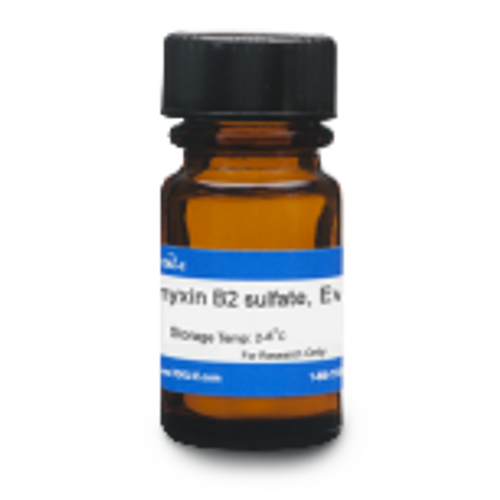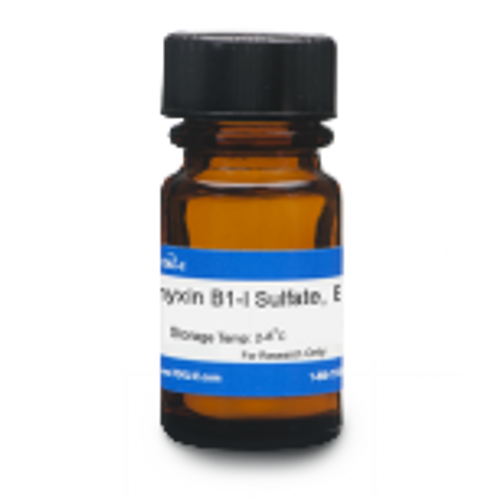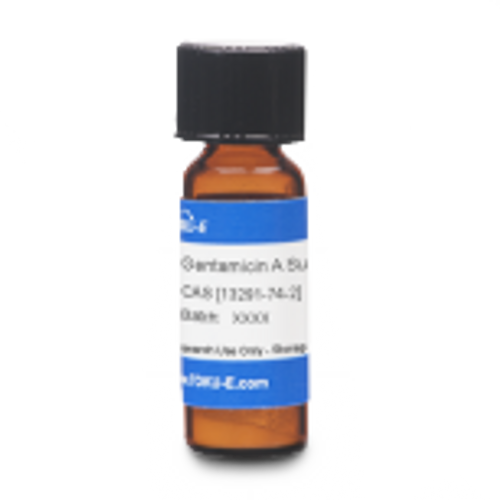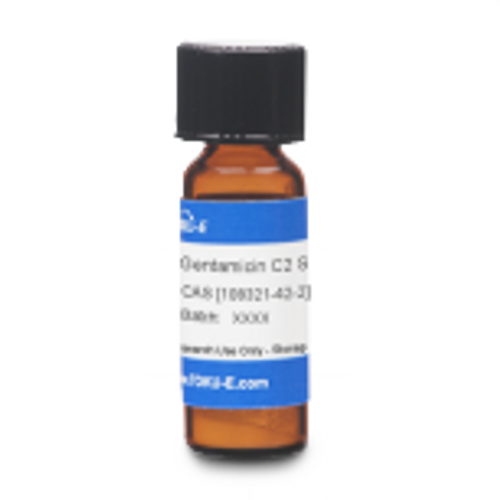Polymyxin B2 Sulfate, EvoPure® is one of several polypeptide components of Polymyxin B Sulfate. The unique fatty acid moiety found in Polymyxin B2 is 6-methylheptanoic acid (6-MHA). Results from in vitro studies have shown marginal differences in MIC data when comparing the fractions.
We also offer:
- Polymyxin B Sulfate (P007)
- Polymyxin B1 Sulfate, EvoPure® (P037)
- Polymyxin B1-I Sulfate, EvoPure® (P038)
- Polymyxin B3 Sulfate, EvoPure® (P040)
- Polymyxin B6 Sulfate, EvoPure® (P054)
- Polymyxin E1 Sulfate, EvoPure® (P055)
- Polymyxin E2 Sulfate, EvoPure® (P056)
EvoPure® products are purified single antibiotic fractions, most are >99% pure. Highly pure Polymyxin products can be used to analyze the specifc effects of individual Polymyxin B fractions.
| Mechanism of Action | Polymyxin B targets and alters permeability lipopolysaccharide (LPS) of Gram-negative bacteria leading to lysing of the cell. Polymyxin B only needs to interact with LPS, it is not required to enter the cell. |
| Spectrum | Polymyxin B Sulfate targets the outer membrane of Gram-negative bacteria especially Pseudomonas aeruginosa. |
| Microbiology Applications | Polymyxin B Sulfate is commonly used in clinical in vitro microbiological antimicrobial susceptibility tests (panels, discs, and MIC strips) against Gram-negative microbial isolates. Medical microbiologists use AST results to recommend antibiotic treatment options. Representative MIC values include:
For a representative list of Polymyxin B Sulfate MIC values, click here.
|
| Plant Biology Applications | Polymyxin B Sulfate was successfully tested to counteract phytopathogenic Gram-negative bacterial growth including different strains of Pseudomonas viridiflava and Erwinia carotovora. Polymixin B Sulfate was shown to reduce bacterial growth of different strains of Pseudomonas viridiflava at low concentrations, (0.08 µg/ml) and Erwinia carotovora growth at slightly higher concentrations (0.25 µg/ml) (Selim et al. 2005). |
| Molecular Formula | C55H96N16O13 · xH2SO4 (lot specific) |
| References |
Kassamali et al used Polymyxin B1, Polymyxin B2, Polymyxin B3, and Polymyxin B1-I (TOKU-E) to test for synergistic and antagonistic effects against various Gram-negative organisms. in "Microbiological assessment of Polymyxin B components tested alone and in combination" Cao G et al (2008) Development and validation of a reversed-phase high-performance liquid chromatography assay for Polymyxin B in human plasma. J. Antimicrob. Chemother. 62(5):1009-1014 PMID 18765414 Mueller MJ, Brodschelm W, Spannagl E and Zenk MH (1993) Signaling in the elicitation process is mediated through the octadecanoid pathway leading to jasmonic acid. Proc. Natl. Acad. Sci. USA 90(16):7490-7494 PMID 11607420 Newton BA (1956) The properties and mode of action of the Polymyxins. Bacter. Rev. 20(1):14-27 PMID 13303920 Orwa JA et al (2001) Isolation and structural characterization of Polymyxin B components. J CHromatogr A 912(2):369-373 PMID 11330807 Selim S, Negrel J, Govaerts C, Gianinazzi S and Tuinen van D (2005) Isolation and partial characterization of antagonistic peptides produced by Paenibacillus sp. strain B2 isolated from the sorghum Mycorrhizosphere. Appl. Environ. Microbiol. 71(11):6501–6507 PMID 16269674 Tam VH, Cao H, Ledesma KR, Hu M et al (2011) In vitro potency of various Polymyxin B components. 55(9):4490-4491 PMID 21709096 Zavascki AP, Goldani LA, Li J and Nation RL (2007) Polymyxin B for the treatment of multidrug-resistant pathogens: A critical review. J. Antimicrob. Chemother. 60(6):1206-1215 PMID 17878146 |
| MIC | P. aeruginosa (ATCC 27853)| 2 |1666| A. baumannii (ATCC BAA 747)|1|1666| K. pneumoniae ATCC 13883|2|1666| P. aeruginosa (9019)|2|1666| A. baumannii (1261)|2|1666| K. pneumoniae (VM9)|2|1666| |












